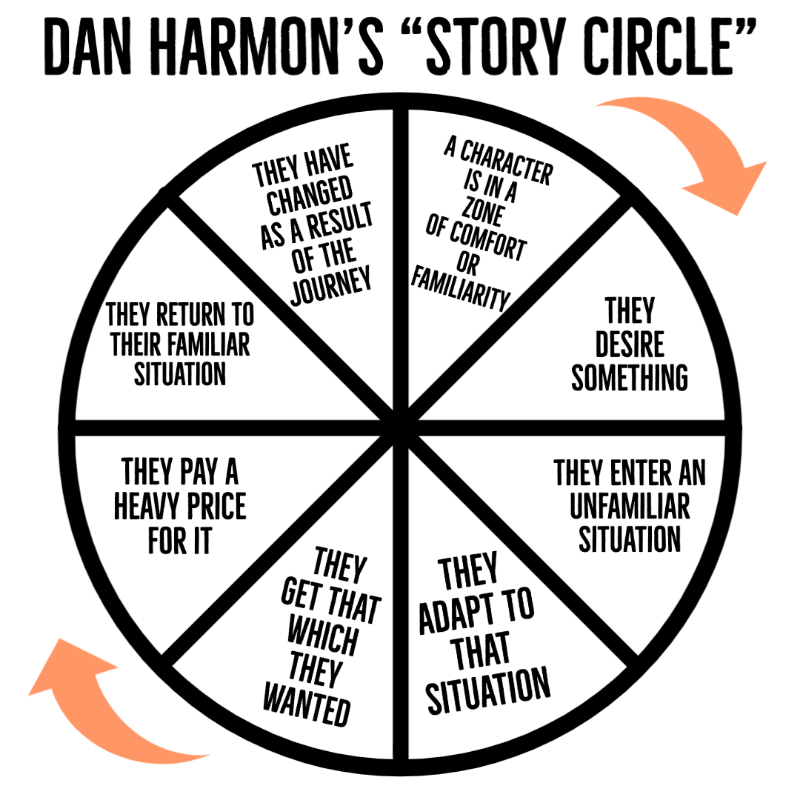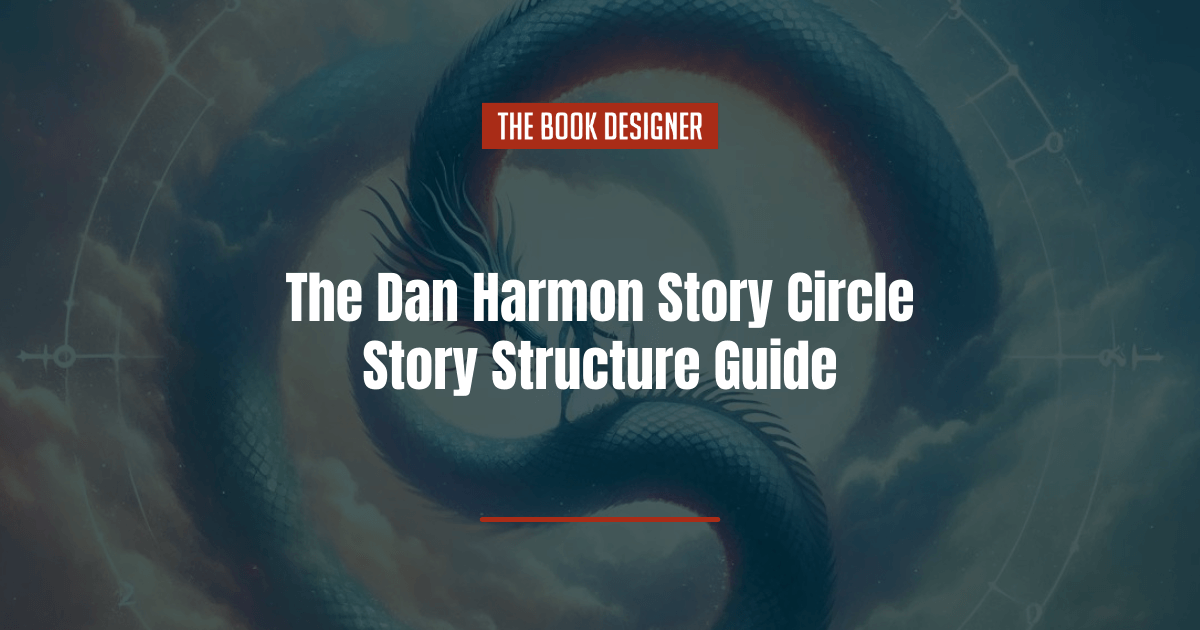For thousands of years, stories have followed a simple pattern called “the hero’s journey.” The term was coined quite recently by an American professor, Joseph Campbell in 1949. Campbell noticed that many stories from different cultures follow the same pattern: a hero leaves home, faces problems, solves them, and comes back changed, often with new knowledge or insights.
Dan Harmon, the creator of TV shows like Community and Rick and Morty, simplified Campbell’s idea for TV. He broke down the journey into eight easy steps that would fit well in a short TV show episode.
However, the Dan Harmon Story Circle isn’t just for TV. It’s a handy tool for writers of all genres to make their stories gripping by focusing on the hero’s journey’s key parts. The Story Circle emphasizes the cyclical nature of hero stories, showing how people grow and change.
This article will look at the Story Circle’s eight steps, show how it’s used in different kinds of stories, and give tips on using it in your writing:
The Eight Steps of the Dan Harmon Story Circle
The Dan Harmon Story Circle is a powerful tool that breaks down the hero’s journey into eight easy steps. This method helps writers craft compelling narratives by focusing on the growth and change of their characters.

Let’s have a closer look at how these principles work on Rick and Morty episodes:
1. You (Comfort Zone)
Every story starts with the main character, or protagonist, in their everyday life. At this point, we see them at their baseline before anything changes. For example, many episodes of Rick and Morty start with Morty in his regular life at school or with his family, setting the stage for future adventures.
2. Need (Want Something)
Soon, the protagonist realizes they want or need something that will push them out of their comfort zone. In Rick and Morty, Morty might be pulled into an adventure by Rick, or he might want to prove himself or help someone in need.
3. Go (Enter an Unfamiliar Situation)
To get what they want or need, the protagonist must enter a new and unfamiliar situation. This could be a physical place they’ve never been to or a challenge they’ve never faced. Rick and Morty step into new dimensions, planets, or bizarre situations far from normal life.
4. Search (Adapt to It)
In this new situation, the protagonist must adapt. They face obstacles and meet allies or enemies. Morty, often reluctantly, has to navigate through the strange and dangerous worlds Rick takes him to, learning and adapting as he goes.
5. Find (Achieve the Goal)
Eventually, the protagonist finds what they are looking for: the solution to a problem, the answer to a question, or the achievement of a goal. However, it’s usually not what they expected. Rick and Morty might solve the issue at hand, but unexpected outcomes or new problems often arise.
6. Take (Pay the Price)
Achieving their goal comes with a cost. This might be a personal sacrifice or a realization that changes how the protagonist sees the world. In Rick and Morty, this could be a moral dilemma that Morty faces or a consequence of their actions that affect others.
7. Return (To Familiar Situation)
With their goal achieved but at a cost, the protagonist begins their journey back to their original world or situation. However, their experiences change them. Rick and Morty return home from their adventures, but Morty is often different in some way —wiser, more aware of the universe’s complexity, or just traumatized by the adventure.
8. Change (Having Grown)
The story ends with the protagonist having grown or changed from their experiences. They have a new understanding or have been transformed in some significant way. Through his adventures with Rick, Morty learns about responsibility, the value of life, and the vastness of the universe, affecting how he sees his own life.
This structure of a story is easily adaptable. For example, though Morty often follows the Story Circle step by step, Rick, who is more of an antihero, usually operates outside these steps. He rarely leaves his comfort zone and only occasionally faces consequences. Other family members like Beth, Jerry, and Summer have their arcs, sometimes intersecting with Morty’s, which proves that this approach can fit all kinds of characters.
Practical Application of the Dan Harmon Story Circle
This plot structure can be applied to various types of stories, including television, films, literature, and more. It helps create engaging narratives that focus on character growth and transformation.
Let’s look at how these character circular journeys play out in different types of media:
Films
- Toy Story: Woody and Buzz’s adventure turns rivalry into friendship.
- Inception: Cobb’s dream journey brings him personal redemption.
- Star Wars (Original Trilogy): Luke Skywalker evolves from farm boy to Jedi Knight.
Literature
- The Hunger Games: Katniss Everdeen becomes a reluctant hero and symbol of revolution, finally returning home at the end of the story.
- The Harry Potter Series: Harry Potter’s journey from obscurity to heroism.
- The Hobbit: Bilbo’s adventure reveals his courage and brings riches.
Video Games
- Skyrim: A prisoner discovers they’re the Dragonborn, embarks on a quest, and changes Skyrim forever.
- The Last of Us: Joel’s mission to protect Ellie leads to moral dilemmas and deep bonds.
- Life is Strange: Max’s time-rewinding ability impacts her future and teaches her about consequences.
Looking closely, one can see that many stories emphasizing character development follow the Dan Harmon story structure.
Writing Tips Using the Dan Harmon Story Circle
Using the Story Circle can make a simple story into a compelling journey of character growth and transformation.
Here are the most crucial do’s and don’ts to keep in mind when structuring your stories using this framework:
Do:
- Clearly Define Each Step: Make sure each of the eight steps is distinctly portrayed in your narrative. This clarity helps your audience follow the protagonist’s journey and understand their development.
- Focus on Character Growth: The heart of the Story Circle is the protagonist’s transformation. Ensure that your story clearly shows how and why your character changes from beginning to end.
- Connect the Steps: Each step should logically lead to the next. Ensure your story moves smoothly, with each event pushing your main character along their path.
- Make the Stakes Clear: For a story to be engaging, the audience must understand what’s at risk. Clearly articulate what the protagonist stands to gain or lose at each step of the circle.
Don’t:
- Rush the Introduction: Establish the protagonist’s initial comfort zone. The impact of their journey is measured by where they started.
- Ignore the Costs: Skipping over the prices paid for achievements can leave a story feeling shallow. The sacrifices and consequences make the journey meaningful.
- Neglect the Return: The protagonist’s return to a familiar situation, albeit changed, is crucial. It’s the culmination of their journey and showcases their transformation.
- Overcomplicate: Simplicity is the key feature of this plot structure, so keep the story simple. Each step should be clear and contribute directly to the protagonist’s journey.
With the right approach, the Dan Harmon Story Circle can help you craft well-structured and coherent narratives that resonate with your audience.
Conclusion
The Dan Harmon Story Circle is a great tool for any type of story, whether a classic book or a new video game. It simplifies the hero’s journey into a smaller number of steps that allow the characters to grow and change.
Experimenting with the Story Circle in your work can unlock new depths in your storytelling. This approach can help you write engaging stories that will remain with your audience long after their conclusion.




